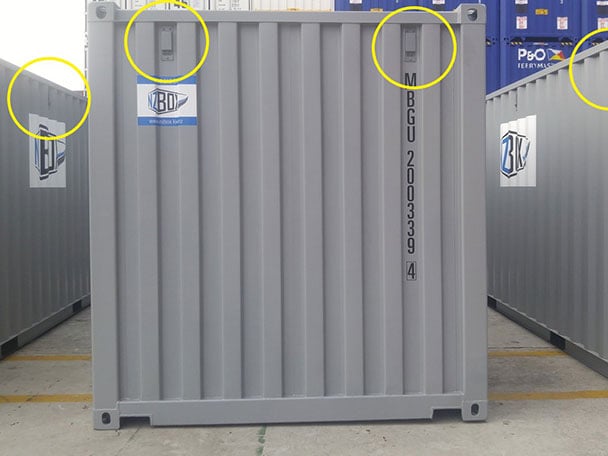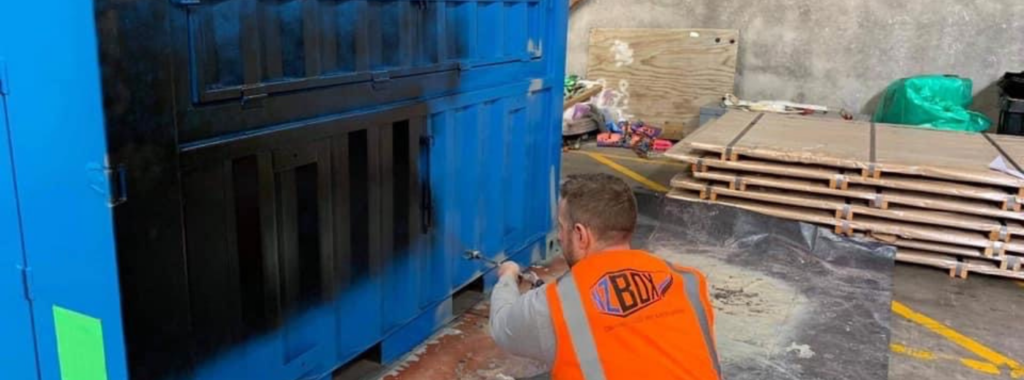Shipping containers are the backbone of global trade – their steel structures comfortably house everything from consumer goods to building materials as they traverse oceans. Beyond their use in logistics, eco-friendly builders and storage businesses value them for their durability and versatility. But an important question looms: Can these seemingly invincible containers succumb to rust?
Understanding this threat is vital for logistics professionals, builders, and anyone invested in the longevity of these cargo carriers. Let’s take a closer look at the primary causes of corrosion and the ways to maintain the structural integrity and reliability of these essential units.
Understanding Rust
Rust is the common name for iron oxide, which forms when iron – a primary component of steel – reacts with oxygen in the presence of water. This chemical reaction is an electrochemical process known as corrosion. While shipping containers are designed to withstand harsh conditions, they aren’t impervious to rust formation, especially if certain contributing factors are left unchecked.
Factors Affecting Shipping Container Rust
The likelihood of rust forming on shipping containers is influenced by various factors, ranging from environmental conditions to the quality of maintenance. It is essential to delve into these aspects to fully comprehend the risks and develop effective strategies for rust prevention. In this post, we will explore each of these contributing factors in detail, offering insights into recognising early signs of corrosion and preserving the condition of these fundamental units of global commerce.
Exposure to Moisture and Humidity
Shipping containers often face continuous exposure to moisture, especially when travelling across high seas and through various climates. Humidity can invade even when stationary if containers are used in coastal regions or places with high rainfall. Prolonged exposure to such conditions without adequate protection can fast-track the rusting process.
Quality of Container Materials
Not all containers are created equal. The quality of steel and the manufacturing process play critical roles in determining how resistant a container is to the elements. Weathering steel, often known as COR-TEN steel, is commonly used for its superior corrosion resistance compared to regular carbon steel. The blend of alloys ensures a more substantial barrier against the weathering process.
Maintenance and Care
A shipping container’s lifespan largely depends on maintenance routines. Containers that are neglected, dented, or scratched may start showing signs of rust more quickly. Regular care, including prompt repairs to surface damage, is essential to prevent moisture from corroding the steel.
Preventing Container Rust
To ensure that shipping containers retain their structural integrity and utility over time, it is important to employ robust rust prevention strategies. These strategies encompass a multifaceted approach, which includes the use of protective coatings, regular inspections, and timely interventions. By initiating preventative measures, the lifetime of these vital units of cargo can be substantially extended, leading to improved cost-efficiency and reliability in the logistics chain. Below, we discuss various methods and best practices that can be deployed to safeguard shipping containers against the relentless onset of rust.
Proper Insulation and Ventilation

Proper insulation can control condensation inside a shipping container, hindering the moist environment required for rust. Simultaneously, adequate ventilation helps reduce humidity levels, another critical factor causing corrosion.
There are a number of ways you can improve the overall ventilation of your shipping container to help slow down the rusting process including the use of whirly birds, air conditioning units, vents, and moisture absorbers.
Regular Inspections and Maintenance
Routine inspections can catch early signs of rust or damage that could lead to rusting. Addressing these areas before they become problematic is crucial for prevention.
Protective Coatings and Treatments

The application of protective coatings is a proactive measure to guard against rust. These technologies include rust inhibitors and specialised paints that create barriers against moisture intrusion. Regular reapplication and attentive care are needed to maintain their efficacy.
Benefits of Rust Prevention
The proactive prevention of rust on shipping containers not only preserves their structural integrity but also brings about significant economic and operational advantages. Effective rust prevention strategies can result in extended service lifespans, diminished need for costly repairs, and a reduction in potential cargo damage due to container breaches. Furthermore, such maintenance efforts enhance the safety standards of container handling and transport, ultimately reinforcing the robustness of the supply chain. The following section delves into the array of benefits that arise from diligent rust prevention practices.
Prolonged Container Lifespan
The primary benefit of diligent rust prevention is an extended lifespan for the container, reducing the frequency of costly replacements and contributing to business sustainability.
Cost Savings in Repairs and Replacements
Preventative care is always more cost-effective than corrective measures. Investing in rust prevention can save ample amounts in future repair bills or the need for new containers.
Environmental Sustainability
By maximising the life of each container, businesses diminish their environmental impact by reducing the demand for new steel and the associated energy consumption and carbon emissions of production and transport.
Summary
Shouldering the responsibility of rust prevention can lead to significant performance and economic dividends for your containers. However, it’s important to understand that consistent maintenance is much like a chain – a solitary weak link can compromise the entire structure. As such, integrated care strategies are essential for optimal container performance.
If you are interested in buying a shipping container or hiring a shipping container in New Zealand, get in touch with the NZBOX team today and we can talk to you about the best options for either new or used containers.
FAQs
How do you keep the rust off a shipping container?
Regular maintenance, including the use of proper insulations, appropriate coatings, and scheduled inspections, will keep rust at bay.
How long does it take for a shipping container to rust?
The timeline varies based on environmental exposure, container quality, and care. Without preventative measures, rust can appear in as little as 1-2 years in harsh conditions.
Why don’t shipping containers rust?
Shipping containers do rust over time, but those made with COR-TEN steel and provided with regular care can resist corrosion far more effectively than others.
What is the lifespan of a shipping container?
A well-maintained container can last 10 to 35 years, depending on usage and environmental exposures.
Investing in routine care, understanding the risk factors for rust, and applying appropriate preventative measures will ensure your containers continue to play their critical role in your operations while maintaining a healthy bottom line.









